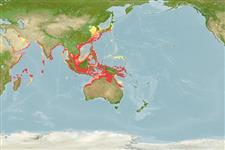>
Carangiformes (Jacks) >
Carangidae (Jacks and pompanos) > Caranginae
Etymology: Megalaspis: Greek, megas, megalos = great + Greek, aspis,-idos = shield (Ref. 45335).
More on author: Linnaeus.
Environment: milieu / climate zone / depth range / distribution range
นิเวศวิทยา
เกี่ยวกับทะเล,น้ำเค็ม; กร่อย เกี่ยวกับหินโสโครก; ระดับความลึก 20 - 100 m (Ref. 28016). Tropical; 47°N - 22°S, 40°E - 156°E (Ref. 54577)
Indo-West Pacific: East Africa to Japan and Australia.
Length at first maturity / ขนาด / น้ำหนัก / Age
Maturity: Lm 22.0 range ? - ? cm
Max length : 80.0 cm TL เพศผู้/กระเทย; (Ref. 3287); common length : 45.0 cm TL เพศผู้/กระเทย; (Ref. 5450); น้ำหนักสูงสุดที่มีการรายงาน: 4.0 kg (Ref. 4883); อายุสูงสุดที่ได้รายงาน: 5 ปี (Ref. 104735)
เงี่ยงครีบหลัง (รวม): 9; ก้านครีบอ่อนที่หาง (รวม): 18-20; เงี่ยงครีบก้น 3; ก้านครีบอ่อนที่ก้น: 16 - 17.
Adults are primarily oceanic, pelagic schooling species rarely seen on reefs (Ref. 48635, 90102). They feed mainly on fishes (Ref. 5213). Generally marketed fresh (Ref. 5284).
Paxton, J.R., D.F. Hoese, G.R. Allen and J.E. Hanley, 1989. Pisces. Petromyzontidae to Carangidae. Zoological Catalogue of Australia, Vol. 7. Australian Government Publishing Service, Canberra, 665 p. (Ref. 7300)
IUCN Red List Status (Ref. 130435)
Threat to humans
Harmless
Human uses
การประมง: เน้นการพาณิชย์
ข้อมูลเพิ่มเติม
อ้างอิงการเพาะเลี้ยงสัตว์น้ำประวัติการเพาะเลี้ยงสัตว์น้ำสายพันธุ์พันธุศาสตร์ElectrophoresesอัตราพันธุกรรมโรคการแปรรูปNutrientsMass conversion
เครื่องมือ
Special reports
Download XML
แหล่งที่มาจากอินเตอร์เน็ต
Estimates based on models
Preferred temperature (Ref.
123201): 23.5 - 28.6, mean 27.5 °C (based on 707 cells).
Phylogenetic diversity index (Ref.
82804): PD
50 = 1.0000 [Uniqueness, from 0.5 = low to 2.0 = high].
Bayesian length-weight: a=0.01288 (0.01159 - 0.01432), b=2.93 (2.90 - 2.96), in cm total length, based on LWR estimates for this species (Ref.
93245).
ระดับชั้นอาหาร (Ref.
69278): 3.9 ±0.57 se; based on food items.
ความสามารถในการกลับคืนสู่ปกติ (Ref.
120179): ขนาดกลาง, เวลาต่ำสุดที่จะทำให้ประชากรเพิ่มขึ้นเป็น 2 เท่าใช้เวลา 1.4 - 4.4 ปี (K=0.13(?)-0.35; Fec=146,400).
Prior r = 0.57, 95% CL = 0.37 - 0.85, Based on 20 stock assessments.
Fishing Vulnerability (Ref.
59153): Low to moderate vulnerability (29 of 100).
Climate Vulnerability (Ref.
125649): Very high vulnerability (86 of 100).
Nutrients (Ref.
124155): Calcium = 140 [25, 418] mg/100g; Iron = 1.59 [0.48, 3.65] mg/100g; Protein = 20.8 [19.1, 22.3] %; Omega3 = 0.198 [0.093, 0.452] g/100g; Selenium = 69.4 [22.3, 176.7] μg/100g; VitaminA = 23.1 [5.0, 132.0] μg/100g; Zinc = 0.544 [0.132, 1.912] mg/100g (wet weight); based on
nutrient studies.
